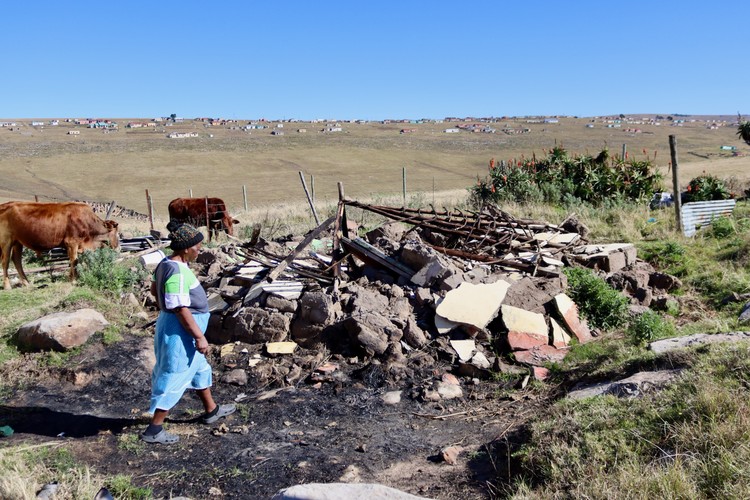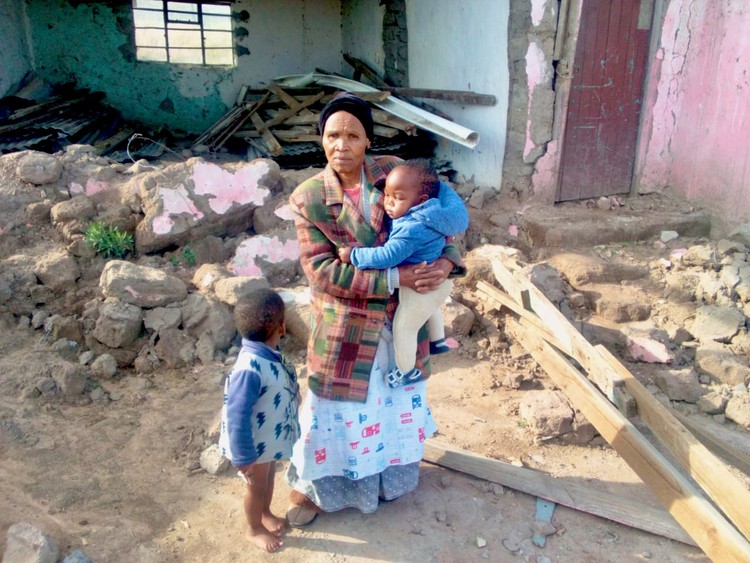Rural Eastern Cape flood victims left to fend for themselves
The homes of 25 families were destroyed in December 2022. They have received no help to date
Nowezile Mlonjana with her two grandchildren at their home wrecked by floods in December 2022 in the rural Eastern Cape. Photos: Manqulo Nyakombi
- 25 families lost their homes in floods in the Butterworth area, Eastern Cape, in. December 2022.
- Those without alternative accommodation were promised bungalows, but to date they have received no government assistance.
- The local municipality says it is in the hands of the provincial Department of Human Settlements and the Amathole District Municipality.
The homes of 25 families, mostly of them self-built with mud bricks, were destroyed by floods in December 2022 in Ngqamakhwe, near Butterworth, in the rural Eastern Cape. The families say that to date they have received no assistance from government.
“The officials only came here once, taking pictures of us living with empty promises. People lost their belongings, some lost their food. Not a single food parcel was delivered,” says Phumla Ntabeni, whose rondavel was destroyed.
She is among the lucky few to own other structures that did escape the floods.
“Sad part is that there were officials who were here – taking pictures, promising to help our grandmothers, giving them false hope,” says Dumisani Tshuku, Ngcisininde Komkhulu village community leader.
“If you look at [Nowezile] Mlonjana’s house, it’s a disaster. She only has that one room left in the house which can fall on her any day,” said Tshuku.
Mlonjana is 73 and has two one-year-old grandchildren.
“I had a six-roomed house as you can see. The floods destroyed five rooms. I am now left with this one room I’m using,” she said.
The room has a hole at the back wall covered by a zinc sheet. The roof is precarious, is leaking, and could collapse.
“I’m relying on an old age grant and the child support grants of my two grandchildren. My son, who assisted me in building this house, passed away. I’m left with my granddaughter who is in East London looking for a job,” said Mlonjana .
But she is still hoping the government will help her.
“When I see a car passing my house, I always jump outside to check if it’s not looking for me,” she says.
Mlonjana said officials had assured her she would get a bungalow for accommodation by February.
“I don’t know how many times I went to the ward councillor’s home, asking him to come and see my house,” she says. “The officials he sent to take pictures saw this house, and even said I should be moved immediately. Since that day, no one has returned. Even the ward councillor I voted for has not set his foot in this house.”
Mnquma Local Municipality spokesperson Loyiso Mpalantshana confirmed that officials were sent to assess the damage and verify how many people were displaced.
He said this information was sent to the Amathole District Municipality, which is responsible for disaster management, and to the provincial department for human settlement. He said the municipality can provide land should the department provide housing.
Questions sent to the Eastern Cape Department of Human Settlements spokespersons Caswell Mabunda and Phiwokuhle Soga more than a week ago have never been answered.
Ward Councillor Lunga Dyantyi said the department promised to deliver 22 temporary structures, but nothing was delivered. He said Amathole District Municipality had also done nothing.
Dyantyi said there are disaster victims from 2017 who are still waiting for temporary structures.

Phumla Ntabeni walks where her rondavel once stood before it was destroyed by floods
Next: Video: Meet Hout Bay’s Super Sandman
Previous: Hundreds march to Gugulethu clinic demanding better service
© 2023 GroundUp. This article is licensed under a Creative Commons Attribution-NoDerivatives 4.0 International License.
You may republish this article, so long as you credit the authors and GroundUp, and do not change the text. Please include a link back to the original article.
We put an invisible pixel in the article so that we can count traffic to republishers. All analytics tools are solely on our servers. We do not give our logs to any third party. Logs are deleted after two weeks. We do not use any IP address identifying information except to count regional traffic. We are solely interested in counting hits, not tracking users. If you republish, please do not delete the invisible pixel.



